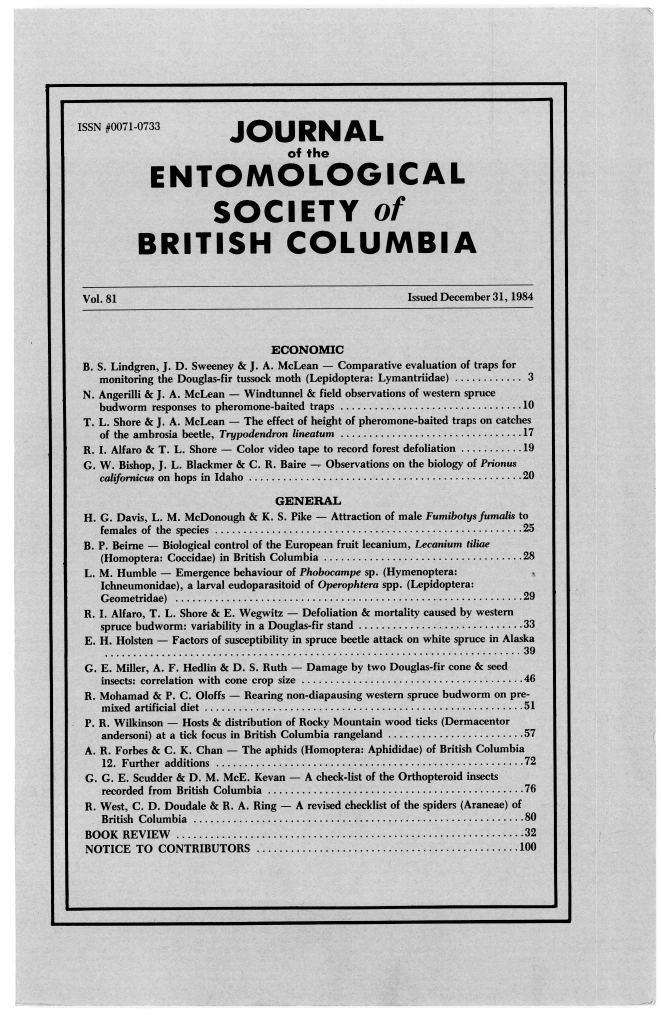Comparative evaluation of traps for monitoring the Douglas-fir tussock moth (Lepidoptera: Lymantriidae)
Keywords:
Douglas-fir tussock moth, Lepidoptera, LymantriidaeAbstract
Delta sticky traps consistently caught at least as many Douglas-fir tussock moths as did five other trap types in field experiments. Omni-directional non-sticky traps based on the Lindgren multiple funnel trap were relatively successful, but highly variable. Wind tunnel tests with a simulated pheromone (= titanium tetrachloride smoke), showed that plums generated from Lindgren 2-funnel traps contaminated the exterior surfaces of the traps and inhibited entry. Modified Lindgren 2-funnel traps with a plastic insert to reduce turbulence in the plume and with collecting jars containing water only, caught significantly fewer Douglas-fir tussock moths than traps with empty jars or jars containing soupy water or DDVP insecticide (No-Pest Strip). Traps with jars containing soapy water caught more Douglas-fir tussock moths than traps with jars containing DDVP, but catches were not different from those in traps with empty jars. The catches in traps with empty jars and jars containing DDVP were not significantly different.
Non-sticky traps show promise for monitoring the Douglas-fir tussock moth. However, improved designs must facilitate rapid capture of moths landing on the trap, and contamination of exterior surfaces must be minimized.
References
Angerilli, N.P.D. and J.A. McLean. 1984. Windtunnel and field observations of western spruce budworm to pheromone-baited traps. J. Entomol. Soc. B.C. 81:10-16.
Daterman, G.E. 1974. Synthetic sex pheromone for detection survey of European pine shoot moth. U.S. Dept. Agric., Pac. Northwest For. and Range Exp. Stn. For. Serv. Res. Paper PWN-180. 12 pp.
Daterman, G.E., L.J. Peterson, R.G. Robbins, L.L. Sower, G.D. Daves, and R.G. Smith. 1976. Laboratory and field bioassay of the Douglas-fir tussock moth pheromone, (Z)-6-heneicosen-11-one. Environ. Entomol. 5:1187-1190.
Fellin, D.G. and P.W. Hengel. 1983. Deploying pheromone-baited traps for the western spruce budworm and other defoliating insects. U.S. Dept. Agric., Intermountain For. and Range Exp. Stn. For. Serv. Res. Note INT-330. 7 pp.
Kendall, D.M., D.T. Jennings, and M.W. Houseweart. 1982. A large-capacity pheromone trap for spruce budworm moths (Lepidoptera: Tortricidae). Can. Entomol. 114:461-463.
Lewis, T. and E.D.M. Macaulay. 1976. Design and evaluation of sex attractant traps for the pea moth, Cydia nigricana Steph., and the effect of plume shape on catches. Ecol. Entomol. 1:175-187.
Liebhold, A.M. and W.J.A. Volney. 1984. Effect of foliage proximity on attraction of Choristoneura occidentalis and C. retiniana (Lepidoptera:Tortricidae) to pheromone sources. J. Chem. Ecol. 10:217-227.
Lindgren, B.S. 1983. A multiple funnel trap for scolytid beetles (Coleoptera). Can. Entomol. 115:299-302.
Livingston, R.L. and G.E. Daterman. 1977. Surveying for Douglas-fir tussock moth with pheromone. Bull. Entomol. Soc. Am. 23:172-173.
Perry, J.N., C. Wall, and A.R. Greenway. 1980. Latin square designs in field experiments involving sex attractants. Ecol. Entomol. 5:385-396.
Ramaswamy, S B. and R.T. Carde. 1982. Nonsaturating traps and long-life attractant lures for monitoring spruce budworm males. J. Econ. Entomol. 75:126-129.
Richerson, J.V., E.A. Brown, and E.A. Cameron. 1976. Pre-mating sexual activity of gypsy moth males in small field plot tests [Lymantria (=Porthetria) dispar (L):Lymantriidae]. Can. Entomol. 108:439-448.
Sanders, C.J. 1978. Evaluation of sex attractant traps for monitoring spruce budworm populations (Lepidoptera: Tortricidae). Can. Entomol. 110:43-50.
Shepherd, R.F. (In press.) Comparison of pheromone trap designs to catch spruce budworm moths. Proc. IUFRO Conference, Banff, Alberta.
Shepherd, R.F. and T.G. Gray. In press. Pest management of Douglas-fir tussock moth: monitoring endemic populations with pheromone traps to detect incipient outbreaks. Can. Entomol. 116.
Snodgrass, G.L. and W.H. Cross. 1983. The use of DDVP in Leggett trap tops to improve trap efficiency. J. Georgia Ent. Soc. 18:50-53.
Steel, R.G.D. and J.H. Torrie. 1969. Principles and Procedures of Statistics. McGraw-Hill Book Company, Inc., New York, 481 pp.
Struble, D.L. 1983. Pheromone traps for monitoring moth (Lepidoptera) abundances: Evaluation of cone orifice and omni-directional designs. Can. Entomol. 115:59-65.
Downloads
Published
Issue
Section
License
Authors who publish with the Journal of the Entomological Society of British Columbia agree to the following terms:
-Authors retain copyright and grant the journal right of first publication with the work simultaneously licensed under a Creative Commons Attribution License that allows others to share the work with an acknowledgement of the work's authorship and initial publication in this journal.
-Authors are able to enter into separate, additional contractual arrangements for the non-exclusive distribution of the journal's published version of the work (e.g., post it to an institutional repository or publish it in a book), with an acknowledgement of its initial publication in this journal.
-Authors are permitted and encouraged to post their work online (e.g., in institutional repositories or on their website) prior to and during the submission process, as it can lead to productive exchanges, as well as earlier and greater citation of published work (See The Effect of Open Access).


